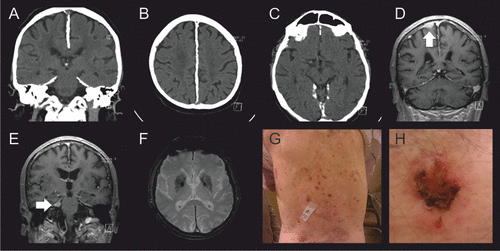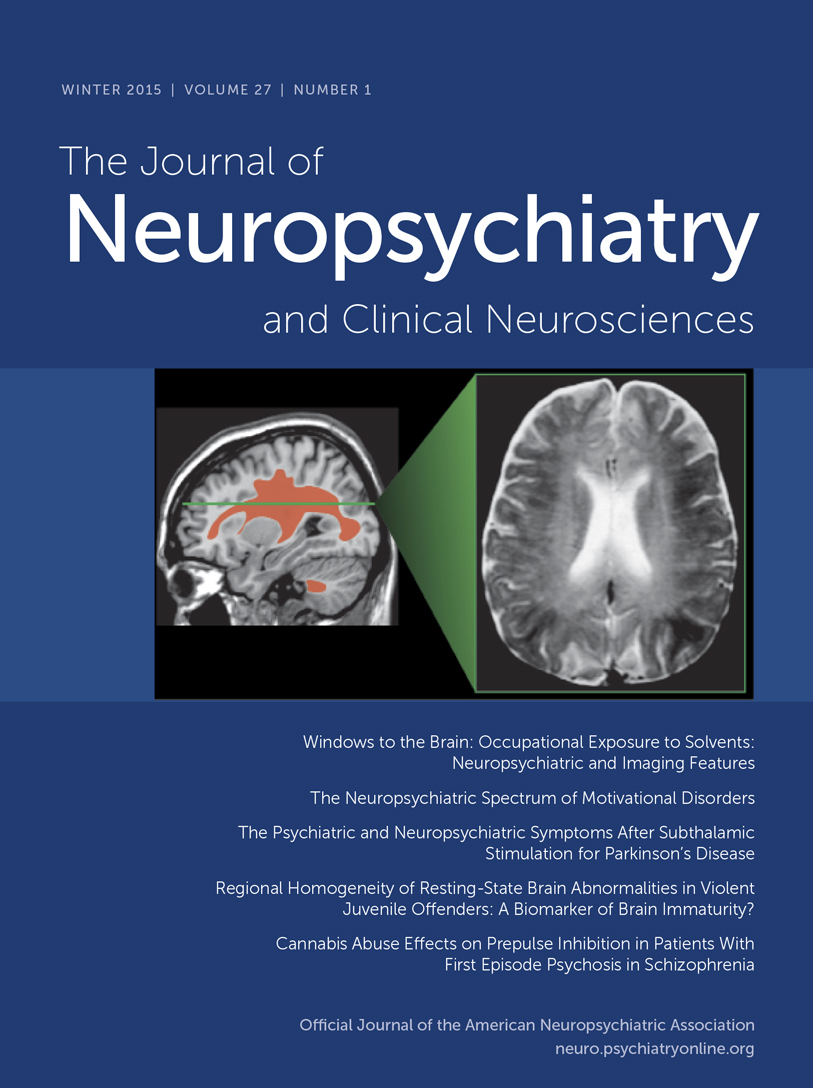Parkinsonism and Gorlin-Goltz Syndrome: More Than an Incidental Association?
To the Editor: Nevoid basal cell carcinoma syndrome, also known as Gorlin-Goltz syndrome, is an autosomal-dominant inherited disorder characterized by maxillary keratocysts, basal cell carcinomas, and skeletal abnormalities. The clinical picture can also encompass neurological signs such as calcification of the falx cerebri and intracranial tumors.1
Case Report
We report on a 73-year-old man complaining about a slowly progressive rest tremor, slowness of movements, and episodes of an inability to initiate walking. A history revealed episodes of brusque motor activity during sleep and hyposmia. His neurological assessment showed an asymmetrical parkinsonian syndrome that clearly improved under therapy with 600 mg/day levodopa (Movement Disorder Society-Unified Parkinson's Disease Rating Scale total score: 53 points before and 18 points after initiation of therapy). The Mini-Mental State Examination and the clock-drawing test were normal.
His medical history included the excision of a dermoid cyst from the trunk and of a maxillary keratocyst at the age of 25 years. A whole-body single photon emission CT (SPECT) excluded further lesions; however, after this examination, the patient developed multiple skin lesions interpreted as basal cell carcinomas (Figure 1). Subsequently, the clinical diagnosis of nevoid basal cell carcinoma syndrome was made. Other signs such as the calcification of the falx cerebri and tentorium cerebelli corroborated the diagnosis. Being an only child, there was no family history of nevoid basal cell carcinoma syndrome.

FIGURE 1. Main Radiological and Clinical Findings
Coronal [A] and transverse [B] CT scans showing calcification of the falx cerebri and tentorium cerebelli. [C]: Transverse CT scan featuring abnormal skull configuration characterized by frontal bossing. [D and E]: Coronal T1-weighted MRI scans with gadolinium. The white arrow indicates the presence of a meningioma of the parietal convexity [D] and within Merkel's cave [E]. [F]: Transverse T2*-weighted MRI scan showing probable calcium deposition within the internal pallidum and putamen. [G and H]: Multiple cutaneous basal cell carcinomas.
T2*-weighted MRI scans of the brain demonstrated a clear hypo-intensity within the basal ganglia compatible with the accumulation of calcium (Figure 1). The patient was also submitted to polysomnography, confirming the clinical suspicion of REM sleep behavior disorder. In consideration of the clinical deterioration after the whole-body SPECT, we did not perform any functional imaging.
Discussion
We had the opportunity to assess a patient with nevoid basal cell carcinoma syndrome and levodopa-responsive parkinsonism. Our patient fulfills the clinical diagnostic criteria for nevoid basal cell carcinoma syndrome,1 whereas parkinsonism and REM sleep behavior disorder indicate the presence of an α-synucleinopathy. We are aware of the possibility of an incidental association of these conditions; however, there are several lines of evidence that argue against a mere coincidence. 1) Nevoid basal cell carcinoma syndrome is caused by mutations in the PTCH1 gene,1 encoding a downstream target of Sonic Hedgehog. Recent findings have demonstrated that the interruption of Sonic Hedgehog signaling in dopaminergic neurons causes progressive, adult-onset degeneration of these neurons producing motor deficits reminiscent of Parkinson’s disease.2 2) Thus far, there are no systematic reports on the neurological complications of nevoid basal cell carcinoma syndrome. However, a recent publication reported the presence of Parkinson’s disease in a patient with nevoid basal cell carcinoma syndrome,3 and another case report described a patient with nevoid basal cell carcinoma syndrome, bilateral striatopallidal calcinosis, and levodopa-unresponsive parkinsonism.4 Two percent of the patients with nevoid basal cell carcinoma syndrome feature striatopallidal calcinosis.5 3) Parkinson’s disease is probably associated with an increased risk of skin cancer, i.e., melanoma.
In summary, there are two potential mechanisms by which nevoid basal cell carcinoma syndrome may be associated with extrapyramidal disorders such as parkinsonism, i.e., dopaminergic neurodegeneration due to an impairment of Sonic Hedgehog signaling and/or basal ganglia calcinosis. It seems worthwhile to screen patients with nevoid basal cell carcinoma syndrome for the presence of such neurological comorbidity and, in case of an association of these conditions, to subsequently correlate the genotype and neuroradiological findings with the phenotype.
1 : Clinical manifestations in 105 persons with nevoid basal cell carcinoma syndrome. Am J Med Genet 1997; 69:299–308Crossref, Medline, Google Scholar
2 : Sonic hedgehog maintains cellular and neurochemical homeostasis in the adult nigrostriatal circuit. Neuron 2012; 75:306–319Crossref, Medline, Google Scholar
3 : [Gorlin syndrome (nevoid basal cell carcinoma syndrome)]. Arch Soc Esp Oftalmol 2008; 83:321–324Medline, Google Scholar
4 : Progression of bilateral striopallidal calcinosis and parkinsonism in a case of Gorlin syndrome. J Neuropsychiatry Clin Neurosci 2009; 21:233–235Link, Google Scholar
5 : Radiological features in 82 patients with nevoid basal cell carcinoma (NBCC or Gorlin) syndrome. Genet Med 2004; 6:495–502Crossref, Medline, Google Scholar



